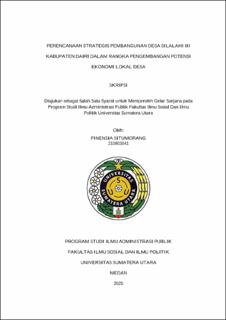Perencanaan Strategis Pembangunan Desa Silalahi III Kabupaten Dairi dalam Rangka Pengembangan Potensi Ekonomi Lokal Desa
Strategic Planning for the Development of Silalahi III Village, Dairi Regency, in the Context of Developing the Village's Local Economic Potential

Date
2025Author
Situmorang, Pinensia
Advisor(s)
Nasution, Muhammad Arifin
Metadata
Show full item recordAbstract
The local economic potential of a village is an important asset for
promoting community growth and welfare. However, efforts to maximize this
potential are often hampered by development programs that are unfocused and
not aligned with the village's vision and mission. Many government programs are
general in nature and do not accommodate the specific strengths of the village,
resulting in suboptimal and unsustainable development. Therefore, a targeted and
sustainable village development plan is needed to optimize local economic
potential. This study aims to describe the process of strategic planning for optimal
village development in the context of local economic potential in Silalahi III
Village, Dairi Regency.
This research uses descriptive research methods with a qualitative
approach, data collection techniques through interviews, observation, and
documentation. Data were obtained and analyzed qualitatively with David and
David's theory (2016) which includes environmental analysis, vision-mission, and
strategy matching and selection.
The results of the study indicate that the strategic planning process for the
development of Silalahi III village has been carried out through a deliberative
planning process to discuss the vision and mission of the village head, the key
points of the Village Council (BPD), and the general initiatives of the community,
thereby formulating strategies for the development of local economic potential.
Although this process has been carried out, the resulting strategies have not fully
focused on the development of existing local economic potential in the village.
The strategic planning process has not been maximized in developing the village's
local economic potential, and there are several shortcomings in the strategic
planning. First, the analysis of the external and internal environment was not
followed up with mapping using the IFE and EFE matrices, making it difficult to
prioritize strategic economic potential. Second, the analysis of the vision and
mission was not thorough, resulting in strategies that are not fully aligned with
the development mission. Third, the selection and implementation of strategies
were not supported by a comprehensive SWOT analysis, relying more on
community consensus and previous strategies. Therefore, there is a need to
improve the quality of environmental analysis through the use of the IFE and EFE
matrices, as well as strengthen the analysis of vision and mission to ensure
alignment with development objectives. Additionally, it is recommended to
conduct a more in-depth SWOT analysis to ensure that the resulting strategies are
more effective in developing the local economic potential of the village.
Collections
- Undergraduate Theses [1936]
